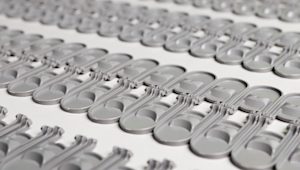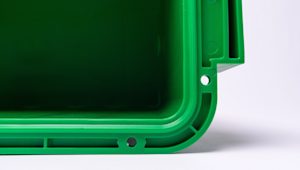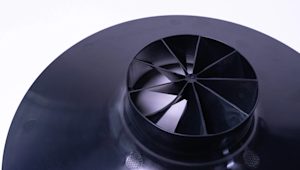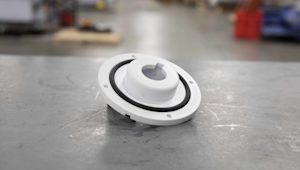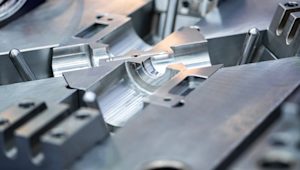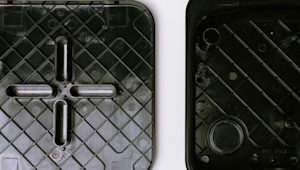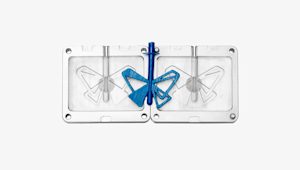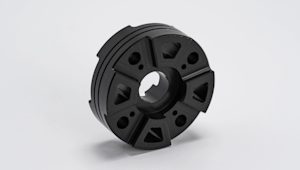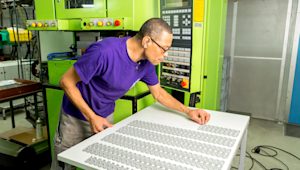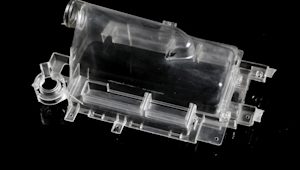Why is material selection important in injection molding?
Injection molding is a widely used manufacturing process that allows for the production of complex and high-volume products. Your part’s effectiveness, however, will depend on the material you select. In this article, we’ll take a look at several of the most commonly used materials in injection molding, as well as examine the material selection process.
The type of plastic you use for injection molding will significantly impact your part’s quality, performance, and cost. Your chosen material must possess properties suitable for the specific application, such as mechanical strength, durability, chemical resistance, and thermal stability.
Additionally, factors like melt flow characteristics, shrinkage, and warping tendencies need consideration to ensure successful molding processes. The type of material also affects the ease of processing, cycle time, tooling requirements, and overall production efficiency.
What materials are commonly used in injection molding?
Thermoplastics, elastomers, and other plastics are most commonly used in injection molding. Each class of material exhibits unique characteristics that are suited to various applications. In the following sections, we will explore the most common materials from each of these categories. Protolabs Network offers each of the materials listed below, and can source even more on request.
What thermoplastics are commonly used in injection molding?
Thermoplastics are used in injection molding because they have the ability to be melted, cooled, and solidified multiple times without significant degradation. This allows for efficient and cost-effective production of complex shapes, as well as facilitates recycling and reusability.
Here are a few of the most commonly used thermoplastics for injection molding.
-
ABS (Acrylonitrile Butadiene Styrene). A lightweight thermoplastic known for its impact resistance and good electrical insulation properties. It also exhibits low-temperature resistance, making it suitable for a wide range of applications such as automotive parts, toys, and electronic housings. ABS falls is the most commonly used material in injection molding, and is one of the most affordable – especially if there are no additives used.
-
PP (Polypropylene). A lightweight thermoplastic with moisture resistance, good chemical resistance, and low-temperature resistance. It is commonly used in packaging, toys, and household items. PP is generally a cost-effective material for injection molding.
-
PE (Polyethylene). A lightweight thermoplastic that is easy to inject, with moisture resistance, good electrical insulation, and low-temperature resistance. It is used in packaging, toys, and household items. PE is generally a cost-effective material that is often used by Protolabs Network customers.
-
PC (Polycarbonate). A transparent thermoplastic with high impact strength, good heat resistance, and excellent electrical insulation properties. It is often used in electronic components, safety glasses, and medical devices. PC is considered a higher-cost material due to its exceptional properties.
-
PA (Nylon/Polyamide). A strong and wear-resistant thermoplastic with good fatigue resistance and heat resistance. It suits applications in mechanical parts, gears, and electrical components. PA is considered a higher-cost material due to its superior properties.
-
HDPE (High-Density Polyethylene). A lightweight thermoplastic with excellent moisture resistance and good chemical resistance. It also offers low-temperature resistance. However, it is not as strong as materials such as ABS or PC, and is prone to warping and shrinking during the injection molding process. HDPE finds applications in packaging, toys, and household items. It tends to be high in cost.
-
PMMA (Polymethyl Methacrylate). A transparent thermoplastic with good weather resistance and optical clarity that can be easily molded into complex shapes and has good dimensional stability. However, it is prone to scratching and cracking under certain conditions, such as exposure to harsh chemicals or high temperatures. It is commonly used in automotive parts, lighting fixtures, and displays. PMMA falls within the moderate cost range.
-
PEEK (Polyether Ether Ketone). A high-performance thermoplastic known for its high temperature resistance, chemical resistance, mechanical strength, and electrical insulation properties. PEEK also has good chemical resistance and can withstand high temperatures and harsh environments. It is widely used in aerospace, medical devices, and electrical components. PEEK is a more expensive material due to its exceptional properties, especially when compared to ABS or PP.
-
HIPS (High-Impact Polystyrene). A lightweight and rigid thermoplastic that exhibits good dimensional stability. It is known for its low cost and finds applications in packaging, toys, and electrical components. HIPS is a versatile material suitable for various consumer products and falls within the moderate cost range.
-
LDPE (Low-Density Polyethylene). A lightweight and flexible thermoplastic material with good chemical resistance and low-temperature resistance. It is commonly used in packaging, toys, and household items. LDPE is a cost-effective material choice for applications that require flexibility and durability.
-
PBT (Polybutylene Terephthalate). A thermoplastic material known for its good dimensional stability, chemical resistance, and impact strength. It is commonly used in electrical components and automotive parts. PBT falls within the moderate cost range.
-
POM (Polyoxymethylene/Acetal). A thermoplastic with low friction, good dimensional stability, high mechanical strength, and chemical resistance. It finds applications in mechanical parts, electrical components, and gears. POM is a high-cost material.
-
PPS (Polyphenylene Sulfide). A high-performance thermoplastic known for its high temperature resistance, chemical resistance, and dimensional stability. It finds applications in electrical components and automotive parts. PPS is considered a higher-cost material due to its exceptional properties.
-
PVC (Polyvinyl Chloride). A lightweight thermoplastic with good chemical resistance and electrical insulation properties. It is commonly used in pipes, electrical cables, and flooring. PVC is generally a low-cost material.
What elastomers are commonly used in injection molding?
Elastomers, such as silicone, and thermoplastic elastomers, such as TPE and TPU, are used in injection molding because they exhibit excellent flexibility and elastic properties. They can undergo significant deformation and return to their original shape, making them suitable for manufacturing products that require resilience, cushioning, and sealing capabilities.
When working with elastomers, however, it is important to know the shore hardness that your part will need, as this can impact the part’s shrinkage and draft angles. You can refer to the image below for more information in that regard.
Here are a few of the most commonly used elastomers for injection molding.
-
Silicone. An elastomeric material known for its excellent temperature resistance, chemical resistance, and flexibility. It finds applications in medical devices, automotive parts, and consumer products, and is relatively expensive due to its specialized properties.
-
TPE (Thermoplastic Elastomer). A thermoplastic elastomer that combines the characteristics of rubber and plastic. It offers good flexibility, chemical resistance, and cost-effectiveness. TPE finds applications in medical devices, consumer products, and automotive parts, and carries a moderate cost.
-
TPU (Thermoplastic Polyurethane). A thermoplastic elastomer known for its flexibility, chemical resistance, and good abrasion resistance. It is commonly used in footwear, automotive parts, and medical devices. TPU falls within the moderate cost range and offers versatility in manufacturing applications.
What other materials are commonly used in injection molding?
Sometimes, certain applications require more-specialized properties. In such cases, manufacturers often turn to other types of materials, such as UHMW.
-
UHMW (Ultra-High Molecular Weight Polyethylene). A lightweight thermoplastic material with exceptional abrasion resistance and chemical resistance. It is often chosen for applications requiring low friction, such as bearings, gears, and mechanical parts. UHMW is considered a higher-cost material due to its specialized properties.
What other factors should you consider when choosing a material for injection molding?
Besides weighing up a material’s properties, you may want to consider the following when choosing a material for injection molding.
-
Environmental considerations. If your part will be exposed to extreme temperatures, moisture, UV rays, or other factors such as high pressure or flames, be sure to select a material that is suited to the environment.
-
Cost-effectiveness. While high-performance materials may offer desirable properties, it is essential to assess the cost. Keep in mind that injection molding offers economies of scale when producing in larger volumes.
-
Aesthetic considerations. If appearance is important, materials with desired color, transparency, or surface finish characteristics should be selected.
-
Post-processing. Evaluate the need for any additional post-processing steps such as surface finishing, painting, or coating to achieve the desired final appearance, texture, or functional requirements of the injection-molded part.
-
Regulatory compliance. Consider any relevant industry standards, regulations, or certifications that the material should meet for the intended application.
Start the injection molding process
Find out more about injection molding with Protolabs Network and request a free quote. You can also find a breakdown of the costs involved in injection molding, how to design parts for molds, a rundown of surface finishes for metal and plastic parts, and tips for avoiding common manufacturing defects.
Frequently asked questions
What is the most commonly used material in injection molding?
PP, ABS, and PE are widely used in injection molding due to their versatility, affordability, and good balance of properties.
What material is suitable for high-temperature applications?
PC offers excellent heat resistance and is often used in applications requiring elevated temperature performance. ABS is also a good choice here, although may require an additive to achieve appropriate heat-resistance – and is more expensive than PC.
Which material is best for impact resistance?
ABS and HDPE provide good impact resistance, making them suitable for durable products and automotive components.
Which material is ideal for transparent parts?
PMMA (Acrylic) is commonly used for transparent or clear parts due to its excellent optical properties.
What material is suitable for flexible applications?
Thermoplastic elastomers (TPE), silicone, PA6 (Nylon), and TPU are often used when flexibility and elasticity are required, such as in seals, gaskets, or soft-touch grips.
How can you save money with injection molded materials?
Optimize material usage by designing parts with efficient geometries, minimize waste, and reduce undercuts to eliminate the need for sliders or post-processing.
What should you consider when choosing a material for injection molding?
Consider factors such as application requirements, performance characteristics, processing requirements, cost-effectiveness, environmental considerations, regulatory compliance, and supplier availability.








